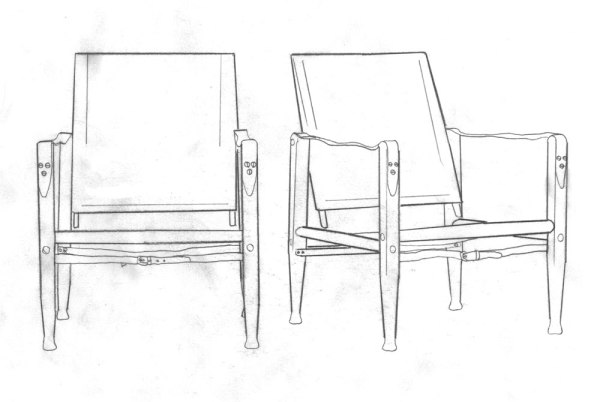
The original 19th-century Roorkee chair looks at home on safari. Whereas the mid-century Kaare Klint ‘Safari Chair’ looks right in the home.
As I have been gathering data on original pieces for the forthcoming book “Campaign Furniture,” a critical piece of the puzzle fell into place Saturday when Mark Firley sent me some measurements he took of some original Kaare Klint chairs. Until now, I’ve been relying on auction records, and those measurements were suspect when compared to dimensions I’d struck off of photographs.
Firley, a woodworker and fine American, took good measurements that will help guide the construction of one last chair before the end of the year.
What is surprising – no shocking – is how closely the Klint chairs mimic the original Roorkee of 50 years earlier. They are so similar that it’s almost not fair to call the Safari Chair anything more than a minor evolution from the original.
Here are some details:
The legs of the original were 1-1/2” square and 22-1/2” long. The Klint chair legs are 1-9/16” square and 22” long.
The stretchers of the original were 1” to 1-1/8” in diameter. The Klint chair has stretchers that are 1-1/4” in diameter that are clearly cigar-shaped. I’ve been making my stretchers this shape to add strength in the middle for some time now. So I was pleased to see the Klint chairs were made this way.
The seat height is also similar between the original and the Klint. On the original, the front of the seat was 12” from the floor and the back of the seat is 10-1/2” from the floor. On the Klint, the front stretcher is 12” from the floor and the rear is 9-1/2” from the floor.
The back is virtually identical.
There are some interesting differences. Klint moved the side stretchers down. This gives the chair a sleeker look in my opinion and – engineering-wise – reduces the leverage on the side stretchers.
Klint also removed the handles at the top of the legs, which is probably the most visible difference, but it has little to do with how the chair sits or works.
Firley also supplied some interesting photos of how the seat of the Klint chair works. The underside of the leather seat is lined with a white cloth to prevent the leather from stretching. Modern chairs use a synthetic fabric to stop stretching; I have no clue what Klint used without some analysis.
So if you have been thinking about making some Safari Chairs and thought to yourself: “I can just change the leg turnings a bit and I’ll be almost done,” then you are thinking correctly.
— Christopher Schwarz